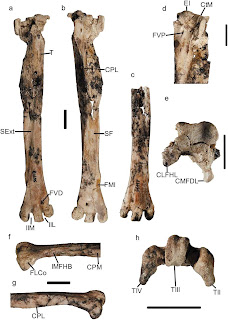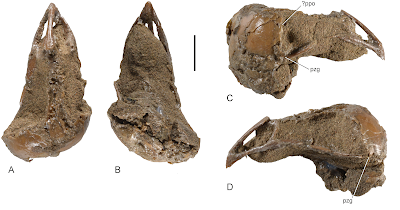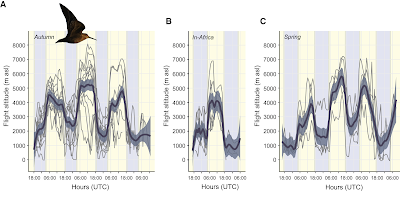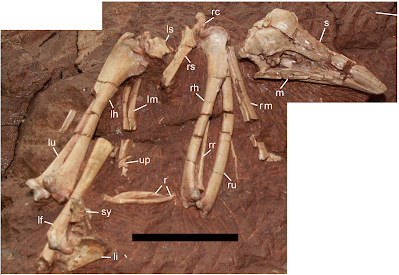By my count, 42 new species of extinct maniraptors were named in 2021, which is about par for the course these days. Let's take a quick look at these new taxa and other nomenclatural proposals.
Alvarezsaurs
New alvarezsaurs have been described at a fairly steady trickle in recent years, and 2021 gave us Khulsanurus, known from a partial skeleton from the Late Cretaceous Barun Goyot Formation of Mongolia. It was discovered at the same locality as Parvicursor, but can be distinguished based on vertebral anatomy.
Oviraptorosaurs
No new oviraptorosaur species were described last year; in fact, they may have lost a member. A new specimen of Elmisaurus preserves overlapping material nearly identical to Nomingia, lending credence to the hypothesis that the two are synonymous (in which case the name Elmisaurus would take priority).
Non-ornithothoracean Paravians
2021 was a good year for dromaeosaurids, with the velociraptorines Shri (formerly known by the nickname "Ichabodcraniosaurus") and Kuru (formerly known by the nickname "Airakoraptor") both described based on partial skeletons from the Barun Goyot Formation. Less completely known are Kansaignathus (based on a partial jaw and possibly teeth from the Late Cretaceous Yalovach Formation of Tajikistan), Vectiraptor (based on partial vertebrae from the Early Cretaceous Wessex Formation of the United Kingdom), and Ypupiara
(an unenlagiine based on jaw fragments from the Late Cretaceous Serra
da Galga Formation* of Brazil). Tragically, the type specimen of Ypupiara was among the fossils lost in the 2018 fire that destroyed the main building of the National Museum of Brazil.
*Ypupiara was described as being from the Marília Formation. However, it was recently proposed that the classic Marília Formation should be split into the separate Marília and Serra da Galga Formations.
 |
| Holotype of Shri, from Turner et al. (2021). |
Troodontids, on the other hand, got Papiliovenator from the Late Cretaceous Wulansuhai Formation of China, known from a partial skeleton including a nearly complete skull. Its name translates (I think quite adorably) into "butterfly hunter", not based on any inference about its ecology, but on the "butterfly-like" shape of its dorsal vertebrae. There was also Tamarro from the Late Cretaceous Talarn Formation of Spain, known from a partial metatarsal. Meanwhile, a detailed reassessment of small theropods from the Dinosaur Park Formation concluded that Latenivenatrix cannot be reliably distinguished from Stenonychosaurus, and that the two should be (re-)synonymized.
 |
| Skull of Papiliovenator, from Pei et al. (2022). (The paper was released as an advance online publication in 2021.) |
Last year also saw the description of a new Jeholornis-like avialan, Neimengornis, from the Early Cretaceous Jiufotang Formation of China. It appears to be known from an essentially complete skeleton. However, there have already been suggestions that the type specimen is likely a chimera.
Enantiornitheans
As is often the case, the Jiufotang Formation also contributed some new enantiornitheans in 2021, two to be precise. One of these was Brevirostruavis, which is notable for preserving an elongated hyoid, suggesting that it may have used its tongue for handling food. Although the original description compares this condition to that seen in hummingbirds and woodpeckers, the hyoid elongation seen in Brevirostruavis does not look to my eye quite as extreme as that of those crown birds. My guess would be that Brevirostruavis might have used its tongue to help pick up food and manipulate it within its mouth, but did not use a feeding strategy that involved protruding the tongue very far beyond its snout.
The other new Jiufotang enantiornithean was Yuanchuavis, which preserves a set of eight tail feathers forming a fan-like array. This contrasts with the typical condition seen in most other enantiornitheans (which tended to either lack large tail feathers or have only a single pair of them), but resembles that of Chiappeavis. Unlike Chiappeavis, the central pair of tail feathers in Yuanchuavis was particularly elongate.
Personally, I think one of the most scientifically important new maniraptors to be named last year was Yuornis from the Late Cretaceous Qiupa Formation of China. It is based on a partial skeleton with an essentially complete skull preserved in three dimensions, a rarity for avialan fossils. It is also one of the few enantiornitheans known to have had entirely toothless jaws.
 |
| Holotype of Yuornis, from Xu et al. (2021). |
A fourth enantiornithean to come out of 2021 was Fortipesavis, known from a foot preserved in Late Cretaceous Burmese amber that had been previously described in 2019.
Non-neornithean Euornitheans
Two non-neornithean euornitheans were named in 2021 based primarily on cranial material, these being Brevidentavis and Meemannavis from the Early Cretaceous Xiagou Formation of China. The type specimen of Brevidentavis was previously reported as the skull of Gansus, but a more likely candidate for an actual Gansus skull was described in the new paper. The lower jaw of Brevidentavis exhibits unusually short, blunt teeth set in a groove (instead of in sockets), whereas Meemannavis has a toothless lower jaw.
 |
| Holotype of Brevidentavis, from O'Connor et al. (in press). |
One Mesozoic avialan named last year that was not discovered in Asia was Kaririavis from the Early Cretaceous Crato Formation of Brazil. Based on a partial foot, it was unusual for a Cretaceous euornithean in being particularly small (around the size of a sparrow) and in that its one preserved toe claw was large and strongly curved.
Paleognaths
Perhaps one of the biggest overhauls in dinosaur systematics in 2021 was the reinterpretation of geranoidids, eogruids, and ergilornithids as stem-ostriches instead of gruiforms. Although a close relationship between ergilornithids and ostriches had been suggested in the 1950s and contemplated more recently in light of further data on fossil paleognaths, anatomical information from newly described eogruid and ergilornithid specimens seems to strongly bolster this hypothesis. In their revision of these birds' affinities, the authors additionally resurrected the genus Proergilornis, which had been previously synonymized with Ergilornis, and suggested that it was less closely related to extant ostriches than ergilornithids proper.
A new fossil paleognath was also described last year, the kiwi Apteryx littoralis, based on a tarsometatarsus from the Pleistocene of New Zealand. Kiwi fossils are rarely found, and this species is the first one known from the early Pleistocene.
Galloanserans
A couple of extinct total-group anseriforms were named in 2021. One of these was the small presbyornithid Bumbalavis from the Eocene Naran-Bulak Formation of Mongolia. (Meanwhile, the type specimen of "Presbyornis" mongoliensis from the same locality was reinterpreted as a stem-mirandornithean similar to Juncitarsus.) The other was the stiff-tailed duck Manuherikia primadividua from the Miocene Bannockburn Formation of New Zealand, the fourth species to be named in the genus Manuherikia. It appears to be stratigraphically separated from the older M. lacustrina.
Two small, early total-group galliforms were described from the Naran-Bulak Formation last year as well, these being Bumbanipodius and Bumbanortyx.
Strisoreans
New fossil members of Strisores don't get described every day, or every year for that matter. (The last one I recall was Cypseloramphus from 2016.) That's why I was excited to see the publication of Archaeodromus from the Eocene London Clay Formation of the United Kingdom, known from a partial skeleton. This new taxon is a member of Archaeotrogonidae (formerly thought to be a group of stem-trogons, as their name suggests, later reevaluated as strisoreans), and not only provides new anatomical information on this group, but also suggests that they may be stem-nightjars. The absence of clear examples of Eocene stem-nightjars had been a conspicuous gap in the known fossil record of Strisores, so the common but enigmatic archaeotrogonids filling that space seems like a tantalizing possibility. It would also imply that my earlier hypothesis that the putative archaeotrogonid Hassiavis was a stem-owlet-nightjar is probably wrong, but that's the way science goes sometimes.
 |
| Shoulder and forelimb bones of Archaeodromus, from Mayr (2021). |
Gruiforms
The Naran-Bulak Formation gave us two more new fossil birds in 2021, the possible gruiforms Bumbanipes and Bumbaniralla. Bumbanipes appears to have been a specialized swimming form with morphological similarities to the limpkin (Aramus guarauna) and finfoots, whereas Bumbaniralla resembles messelornithids. Additional new entrants in the extinct gruiform department were the crane-like Palaeogeranos, based on a coracoid from the Oligocene of France, and the recently extinct rail Gallirallus astolfoi, based on a tarsometatarsus from the island of Rapa Iti in French Polynesia. Recent revisions in the generic assignment of recent rails have restricted the genus Gallirallus to the weka (G. australis) and sometimes the New Caledonian rail (G. lafresnayanus), in which case it wouldn't surprise me if G. astolfoi was transferred to a different genus in the future, perhaps Hypotaenidia. In fact, reassignment to Hypotaenidia was proposed last year for another recently extinct rail, the Chatham rail ("Cabalus" modestus), in one study on rail phylogeny.
Charadriiforms
No new extinct charadriiforms were named in 2021, but a study on the original illustrations used to describe the Moorea sandpiper (Prosobonia ellisi) supported synonymizing it with the Tahiti sandpiper (P. leucoptera).
Natatoreans
There has still been no formal proposal to name the clade uniting Phaethontimorphae and Aequornithes, but last year the name Feraequornithes was coined for the group including most aequornitheans other than loons. As it happens, all of the extinct members of the "waterbird clade" that were named in 2021 belong to Feraequornithes.
The excellent fossil record of total-group penguins continued to provide, with new taxa in the form of the giant Kairuku waewaeroa, based on a partial skeleton from the Oligocene Glen Massey Formation of New Zealand, and the smaller Marambiornopsis, based on a tarsometatarsus from the Eocene Submeseta Formation of Antarctica. Perhaps more surprising was the description of a new fossil petrel based on a well-preserved skeleton, Procellaria altirostris from the Pliocene Tangahoe Formation of New Zealand.
 |
| Holotype of Procellaria altirostris, from Tennyson and Tomotani (2021). |
Among pelecanimorphs, Eopelecanus was described as the oldest known stem-pelican based on a tibiotarsus from the Eocene Birket Qarun Formation of Egypt, whereas a revision of plotopterid specimens from the Paleogene of Washington State resulted in "Tonsala" buchanani being reassigned to Klallamornis.
Telluravians
Although not as many new raptors were named last year as there were in 2020, they were still pretty well represented. Arguably the most exciting was Archaehierax, known from a partial skeleton from the Oligocene Namba Formation of Australia. It was nearly as big as the wedge-tailed eagle (Aquila audax, the largest bird of prey in Australia today), and phylogenetic analyses (which have otherwise almost never been done on fossil accipitrimorphs!) suggest that it was a crown accipitrid, but not especially closely related to any living species.
 |
| Tarsometatarsus of Archaehierax, from Mather et al. (in press). |
The other new fossil accipitrids of 2021 were also quite large species, Buteo dondasi from the Pliocene Chapadmalal Formation of Argentina and Buteogallus irpus from the Pleistocene of the Dominican Republic and Cuba. B. irpus is notably based on specimens formerly assigned to Titanohierax (now restricted to fossils from the Bahamas) and "Amplibuteo" woodwardi (now restricted to fossils from the United States). Its description further suggested sinking members of the genus Amplibuteo into Buteogallus, which had been foreshadowed in previous papers. Another new raptor was the owl Margarobyas abronensis from the Pleistocene of Cuba, a close relative of the poorly-known bare-legged owl (M. lawrencii) that still lives in Cuba today.
Among coraciimorphs, there was Ueekenkcoracias from the Huitrera Formation of Argentina, based on a partial hindlimb. It was described as a stem-member of the group uniting ground rollers and rollers, in which case it would be the first representative of this clade known from South America. However, a later study argued that Ueekenkcoracias more closely resembles the enigmatic Eocene bird Palaeopsittacus, in which case it may not be a telluravian at all. Probably less controversial are the three Pleistocene woodpeckers described from the La Brea tar pits (listed in order of decreasing body size), Breacopus, Melanerpes shawi, and Bitumenpicus.
The London Clay Formation had a good year as far as new fossil birds were concerned, with Tynskya waltonensis revealing new details about messelasturid morphology, though the phylogenetic affinities of these parrot-like birds remain mysterious. Perhaps even more remarkable was the psittacopedid Parapsittacopes, known from a very well-preserved partial skeleton that sheds new light on the anatomy of these stem-passeriforms. It further adds to the already impressive ecological diversity of psittacopedids, exhibiting a slightly widened beak that may have allowed it to feed on fruits and flying insects.
 |
| Skull of the holotype of Parapsittacopes, from Mayr (2020). (The print version of the journal retroactively dates the paper to 2020, but really, the paper was first released in 2021.) |
Last but not least, a few fossil crown passeriforms were also described in 2021, the possible suboscine Crosnoornis, based on a nearly complete skeleton from the Oligocene of Poland, and the magpie Pica praepica from the Pleistocene of Bulgaria.
 |
| Type specimen of Crosnoornis, from Bochenski et al. (2021). |




















